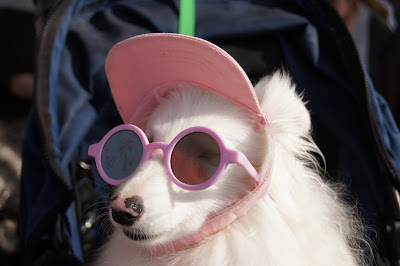There were more great questions sent for my For The Curious series of posts! Thank you to everyone who sent such great questions that people often have about blind/deaf dogs and double merles!
Are your blind/deaf dogs always on a leash or beside you? Are they able to roam freely at home and are they able to navigate a space they are familiar with? What about a space they are unfamiliar with?
My b/d dogs are free to roam in the house or fenced areas. They know the space pretty well. Yes, they do sometimes bump into things, but they know where the furniture is, the doorways, the steps, the toybox and water bowl. When they are outside, they are on leash. They are well trained and will come to find me and check in with me, but they are very valuable to me and I don't take chances with their safety. It would only take one missed cue in a dangerous situation for something bad to happen - since I need to be relatively close to them to give a cue (they can't see or hear me from afar), things could go south pretty quickly. I use long tracking leashes to give them freedom to run and sniff and be dogs.
When we travel, the dogs seem to enjoy sniffing out a new area. They can quickly map out a hotel room or a friend's house, learning where the water bowl is, the furniture, the doors. I encourage them to be independent in as many ways as it is safe to do so, so my dogs learn confidence and how to map out new areas.
I know a double merle that stands between people's legs that he likes - is this common in double merles?
In my experience this isn't something particular to double merles. I know many dogs that stand between someone's legs. In some instances, the dog feels this is a safe place to be while it watches or experiences the world go by. It can feel comforting to the dog to have light pressure on both sides from the person's legs, the same way a thundershirt or TTouch wrap would provide a comforting pressure - like a hug! And, in Vinny's case, he adores being between my legs because he was taught this as a trick and it's one of his favorites!
How do you stop them from barking and from taking things they're not supposed to have?
All dogs bark, not just double merles, not just deaf dogs, and not just blind and deaf dogs, so to stop them from barking, we need to teach them what we want instead. Just telling a dog to be quiet doesn't work, because they don't have any idea what we want them to do, or what quiet means - until we teach them. I start by adding a cue to quiet when the dog is already being quiet and reinforcing all quiet behaviors. As the dog realizes it is the quiet I like, he will start to spend more time being quiet. Barking usually happens for a reason, so when I take care of the reason the dog is barking, AND teach him that I like it when he's quiet, I don't have a problem with excess barking.
With dogs that take things that they aren't supposed to have, I can use the same principle. If I manage the environment to set the dog up for success - by putting away things I don't want him to have, and leaving out things I do want him to have - I will have more opportunities to reinforce him for playing with things he can have. Paying attention to him when he has something I want him to have will go a long way toward encouraging that behavior. But every time I leave something out that I don't want him to have and he gets hold of it, he is reinforcing himself by having fun with that thing. So the behavior won't go away until I take some responsibility and put those things out of my dog's reach.
How does she (blind/deaf) eat?
My dogs eat from puzzle toys mostly and from a dog bowl - probably just like your dogs do. Because I have multiple dogs, they each have their own space to eat around the room, and they know where that space is. They will go to their space when they smell me getting their food ready. They find their food by smell.
Can you housetrain a blind and deaf dog?
Most definitely! Doing our business does not depend on us being able to see or hear - have you ever found your way to the bathroom in the middle of the night without turning the light on? And it doesn't depend on our dog being able to see or hear either.
Teaching a dog to do its business outside is a matter of keeping the dog on a consistent schedule, taking it outside often and supervising when it's inside. Prevent any accidents inside and stay with him outside until he goes - then reinforce. You will need to stay close by because your reinforcement is going to be petting while he is going. In the beginning you can't just put him out in your fenced backyard.
You must be with him to reinforce him for going outside - this is the behavior you want. Behavior that is reinforced will continue! And, if you're not out there with him, you may think he is done and let him inside only for him to go on the floor. Stay out there with him, keep him on a schedule, reinforce behavior you like, and prevent behavior you don't like (accidents in the house).
























